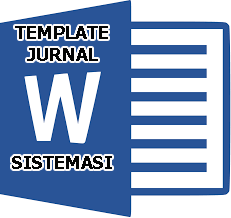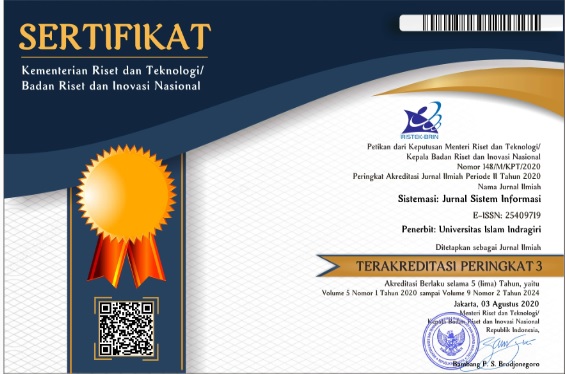Design of the Feeding Frog Cognitive Game for Early Childhood using the Mechanics, Dynamics, and Aesthetics (MDA) Framework and Greenfoot
Abstract
Keywords
Full Text:
PDFReferences
Elfiandi, “Bermain dan Permainan bagi Anak Usia Dini,” ITQAN J. Ilmu-Ilmu Kependidikan, 7(1), 51-60., Vol. 7, No. 1, 2016.
S. N. Hayati and K. Z. Putro, “Bermain dan Permainan Anak Usia Dini,” J. Pendidik. Islam Anak Usia Dini, Vol. 4, No. 1, 2021.
O. Fathurohman, “Hakikat Bermain dan Permainan Anak Usia Dini di Pendidikan Anak Usia Dini (PAUD),” As-Sibyan J. Pendidik. Anak Usia Dini, Vol. 2, No. 1, 2017.
C. Hayat and S. Cancerita, “Pendekatan Model Addie dan Framework MDA pada Gamifikasi Edukasi Pendidikan Seks Anak Usia Dini Addie Model and MDA Framework Approach to Gamification of Sex Education for Early Children,” J. Teknol. Inf. dan Ilmu Komput., Vol. 9, No. 4, 2022.
B. Scholtz, L. Raga, and G. Baxter, “Design and Evaluation of a ‘Gamified’ System for Improving Career Knowledge in Computing Sciences,” African J. Inf. Commun., No. 18, 2016, doi: 10.23962/10539/21322.
J. Harms, C. Wimmer, K. Kappel, and T. Grechenig, “Gamification of Online Surveys: Conceptual Foundations and a Design Process based on the MDA Framework,” in Proceedings of the NordiCHI 2014: The 8th Nordic Conference on Human-Computer Interaction: Fun, Fast, Foundational, 2014. doi: 10.1145/2639189.2639230.
G. P. Kusuma, E. K. Wigati, Y. Utomo, and L. K. Putera Suryapranata, “Analysis of Gamification Models in Education using MDA Framework,” in Procedia Computer Science, 2018. doi: 10.1016/j.procs.2018.08.187.
K. Huotari and J. Hamari, “A Definition for Gamification: Anchoring Gamification in the Service Marketing Literature,” Electron. Mark., Vol. 27, No. 1, 2017, doi: 10.1007/s12525-015-0212-z.
M. Jurgelaitis, L. Čeponienė, K. Butkus, R. Butkienė, and V. Drungilas, “MDA-Based Approach for Blockchain Smart Contract Development,” Appl. SCI., Vol. 13, No. 1, 2023, doi: 10.3390/app13010487.
A. Toto et al., “Urinary Malondialdehyde (MDA) Concentrations in the General Population—A Systematic Literature Review and Meta-Analysis,” Toxics, Vol. 10, No. 4. 2022. doi: 10.3390/toxics10040160.
U. Ruhi, “Level Up Your Strategy: Towards a Descriptive Framework for Meaningful Enterprise Gamification,” Technol. Innov. Manag. Rev., 2015, doi: 10.22215/timreview918.
F. Angelia and Suharjito, “Improving English Learning Through Game using 6-11 MDA Framework,” in Proceedings of 2019 International Conference on Information and Communication Technology and Systems, ICTS 2019, 2019. doi: 10.1109/ICTS.2019.8850951.
M. Zyda, “From Visual Simulation to Virtual Reality to Games,” Computer (Long. Beach. Calif)., 2005, doi: 10.1109/MC.2005.297.
S. D. Putra and V. Yasin, “MDA Framework Approach for Gamification-based Elementary Mathematics Learning Design,” Int. J. Eng. Sci. Inf. Technol., Vol. 1, No. 3, 2021, doi: 10.52088/ijesty.v1i3.83.
S. Xinogalos and M. M. Tryfou, “Using Greenfoot as a Tool for Serious Games Programming Education and Development,” Int. J. Serious Games, Vol. 8, No. 2, 2021, doi: 10.17083/ijsg.v8i2.425.
E. L. Sutigno, O. D. Nurhayati, and K. T. Martono, “Perancangan Media Pembelajaran Alat Musik Pianika menggunakan Greenfoot,” J. Teknol. dan Sist. Komput., Vol. 3, No. 1, 2015, doi: 10.14710/jtsiskom.3.1.2015.36-43.
A. Taufik, T. Apendi, S. Saidi, and Z. Istiarsono, “Parental Perspectives on the Excellence of Computer Learning Media in Early Childhood Education,” JPUD - J. Pendidik. Usia Dini, 2019, doi: 10.21009/jpud.132.11.
K. S. Ekaputra, R. Yuniarti, and A. Komarudin, “Educational Game Design for Introduction to Immune Systems in Biology Learning at High School,” JUMANJI (Jurnal Masy. Inform. Unjani), Vol. 6, No. 1, 2022, doi: 10.26874/jumanji.v6i1.102.
R. Junior and F. Silva, “Redefining the MDA Framework—the Pursuit of a Game Design Ontology,” Inf., Vol. 12, No. 10, 2021, doi: 10.3390/info12100395.
S. Rofiah, “Pengenalan Greenfoot dalam Pembuatan Game berorientasi Objek,” Inf. Manag. Educ. Prof., Vol. 1, No. 2, 2017.
I. Utting, S. Cooper, M. Kölling, J. Maloney, and M. Resnick, “Alice, Greenfoot, and Scratch - A discussion,” ACM Trans. Comput. Educ., Vol. 10, No. 4, 2010, doi: 10.1145/1868358.1868364.
DOI: https://doi.org/10.32520/stmsi.v14i5.5213
Article Metrics
Abstract view : 798 timesPDF - 48 times
Refbacks
- There are currently no refbacks.

This work is licensed under a Creative Commons Attribution-ShareAlike 4.0 International License.









